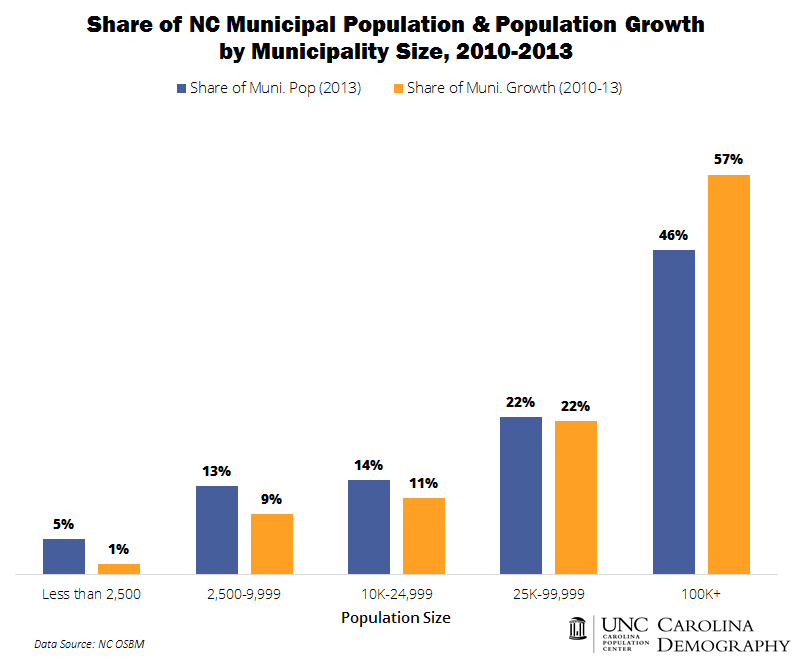The turn of the century marked a key moment in North Carolina’s rural to urban transition: it was the first time in state history that a majority of residents were living in incorporated municipalities. Today, nearly 5.5 million individuals—56% of the state’s population—reside in one of the state’s 552 incorporated municipalities.
These municipalities vary widely in key characteristics related to future growth and planning. The smallest—Fontana Dam Village in Graham County—contains 20 residents. At the other extreme, Charlotte City, the largest municipality in the state, had nearly 790,000 residents in 2013.
Two hundred and nineteen of the state’s incorporated municipalities had fewer than 1,000 residents in 2013. Another 109 had between 1,000 and 2,499.
In total, 59% of the state’s municipalities had fewer than 2,500 residents in 2013. Together, these 328 municipalities contained 15% of municipality land, but only 5% of the state’s municipal population.
Only 3 municipalities—Charlotte, Raleigh, and Greensboro—had more than 250,000 residents in 2013. Another 6—Cary, Durham, Fayetteville, High Point, Wilmington, and Winston-Salem—had between 100,000 and 249,999 residents in 2013. Together, these 9 areas covered 28% of the state’s municipal land area, but held 46% of the state’s municipal population.
Between 2010 and 2013, North Carolina’s municipalities grew by just over 236,000 persons. The smallest municipalities (<2,500 persons) gained only 3,350 new residents, representing 1.4% of all municipal growth since 2010. In contrast, the largest municipalities (>100,000) grew by 135,000 persons or 57% of all municipal growth.
 1 in 3 municipalities have lost population since 2010
1 in 3 municipalities have lost population since 2010
The combined impacts of net out-migration and population aging have contributed to population loss and stagnation among many North Carolina municipalities. Between 2010 and 2013, 182 municipalities lost population and another 24 saw no population growth. More than half of the municipalities experiencing population losses, and nearly all of those with no growth, were among the smallest, with fewer than 1,000 residents in 2013.
Only three municipalities with populations of 25,000 or more have lost population since 2010. All three—Goldsboro, Rocky Mount, and Wilson—are in Eastern North Carolina.
Just under half (49%) of the state’s non-Hispanic white population lived in an incorporated municipality in 2010, compared to 64% of Hispanics, 71% of blacks, and 82% of Asians.
Not only are North Carolina’s Asian residents the most likely to reside in a municipality, they are significantly more likely to live in one of the largest cities in the state. Over half of the state’s Asian population can be found in the 9 municipalities with over 100,000 residents. At the other extreme, only 484 individuals who identified as Asian in 2010 were among the 100,000 residents living in municipalities with fewer than 1,000 residents.
Hispanics are more likely to live in smaller municipalities than Asians, due to their higher representation in agricultural jobs in the state.
There are many ways in which population change is impacting North Carolina’s municipalities. In some cases, the major questions raised are of growth and change: who is coming to our area? And are they different from those that are leaving or those that still live here? In others, the question is one of population loss and potential decline: who is leaving, and who is left behind?
Each case brings its own unique challenges, and these trends are only likely to intensify in the coming decade.
Your support is critical to our mission of measuring, understanding, and predicting population change and its impact. Donate to Carolina Demography today.